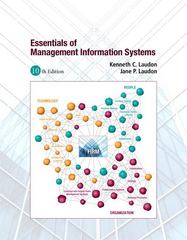Question
1. Which of the following is not a key objective of operations management? a) Cost reduction b) Quality improvement c) Market expansion d) Customer satisfaction
1. Which of the following is not a key objective of operations management? a) Cost reduction b) Quality improvement c) Market expansion d) Customer satisfaction
2. What does JIT stand for in operations management? a) Just In Time b) Just In Case c) Just In Order d) Just In Need
3. Which production process is characterized by producing a high volume of standardized products? a) Mass production b) Job shop production c) Batch production d) Lean production
4. Which quality management technique emphasizes the prevention of defects rather than their detection? a) Six Sigma b) Total Quality Management (TQM) c) Quality Control (QC) d) Quality Assurance (QA)
5. Which forecasting method relies on historical data and assumes that past trends will continue into the future? a) Delphi method b) Time series analysis c) Causal forecasting d) Judgmental forecasting
6. Which of the following is a primary concern of capacity planning in operations management? a) Ensuring product quality b) Maximizing customer satisfaction c) Balancing supply and demand d) Minimizing production costs
7. What does the ABC analysis in inventory management classify items based on? a) Alphabetical order b) Annual sales volume c) Item weight d) Production complexity
8. Which of the following is not a key performance indicator (KPI) commonly used in operations management? a) Return on Investment (ROI) b) Customer satisfaction index c) Employee turnover rate d) Gross profit margin
9. What is the primary goal of supply chain management? a) Maximizing production efficiency b) Minimizing transportation costs c) Meeting customer demand while minimizing costs d) Maximizing inventory levels
10. Which concept in operations management focuses on reducing waste and improving efficiency through continuous improvement? a) Six Sigma b) Lean manufacturing c) Total Quality Management (TQM) d) Just In Time (JIT)
11. Which of the following is not a component of the 5S methodology for workplace organization? a) Sort b) Standardize c) Stabilize d) Shine
12. Which scheduling technique aims to minimize the time it takes to complete a set of tasks by determining the critical path? a) Gantt chart b) PERT (Program Evaluation and Review Technique) c) FIFO (First-In-First-Out) d) LIFO (Last-In-First-Out)
13. What is the primary focus of facility location decisions in operations management? a) Maximizing production capacity b) Minimizing transportation costs c) Minimizing labor costs d) Maximizing market access
14. Which of the following is a key principle of Total Quality Management (TQM)? a) High production volume b) Customer focus c) Minimal process improvement d) Single-source suppliers
15. In operations management, what does the term "bottleneck" refer to? a) A wide point in the production process b) A constraint that limits overall production capacity c) The final stage of production d) The slowest worker in a team
16. Which type of inventory is held to meet unexpected spikes in demand or supply disruptions? a) Safety stock b) Cycle stock c) Anticipation inventory d) Pipeline inventory
17. What is the primary purpose of a quality control chart (e.g., a control chart or a run chart)? a) To forecast future demand b) To monitor the performance of a process over time c) To schedule production tasks d) To determine product pricing
18. What is the main advantage of using a Kanban system in production and inventory management? a) It maximizes production capacity. b) It reduces production lead times. c) It minimizes transportation costs. d) It eliminates the need for quality control.
19. Which production layout arranges workstations in a U-shape and is often used in cellular manufacturing? a) Product layout b) Process layout c) Fixed-position layout d) Cellular layout
20. Which type of inventory cost includes the cost of holding and storing inventory items? a) Ordering cost b) Carrying cost c) Holding cost d) Shortage cost
Step by Step Solution
There are 3 Steps involved in it
Step: 1

Get Instant Access to Expert-Tailored Solutions
See step-by-step solutions with expert insights and AI powered tools for academic success
Step: 2

Step: 3

Ace Your Homework with AI
Get the answers you need in no time with our AI-driven, step-by-step assistance
Get Started


